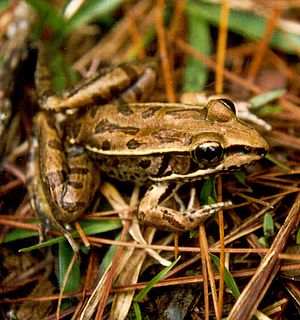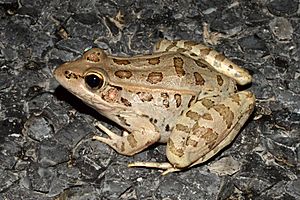Rio Grande leopard frog facts for kids
Quick facts for kids Rio Grande leopard frog |
|
|---|---|
 |
|
| Conservation status | |
| Scientific classification | |
| Synonyms | |
|
Rana berlandieri |
The Rio Grande leopard frog (Lithobates berlandieri), also called the Mexican leopard frog, is a type of frog that loves water. You can find these frogs in the southern United States, especially in Texas and New Mexico. They also live further south in Mexico and Central America. The frog's scientific name, berlandieri, is a tribute to Jean Louis Berlandier, a naturalist who studied animals and plants in Texas a long time ago.
Contents
How to Spot a Rio Grande Leopard Frog
Rio Grande leopard frogs can grow to be about 2.2 to 4.5 inches long. They are usually tan, brown, or light green. They have special black spots and light-colored lines running down both sides of their backs. Their noses are pointed, and they have strong, long legs with webbed feet, which help them swim and jump.
Life and Habits of the Rio Grande Leopard Frog
These frogs mostly live in water and are active at night (this is called being nocturnal). However, you might sometimes see them resting near the water's edge during the day. Even though they live in areas that are often dry, they always stay near places with permanent water, like streams, creeks, and ponds.
What Rio Grande Leopard Frogs Eat
Rio Grande leopard frogs are insectivores, meaning they mainly eat insects. But like most frogs, they will try to eat almost any small creature they can catch and swallow!
Reproduction and Life Cycle
Mating for these frogs happens during the rainy seasons in spring and fall. Male frogs make a loud rattling call that can be heard from far away, sometimes even a quarter-mile or more! The female frogs lay their eggs in large groups. These egg masses are usually attached to plants that grow in the water.
Where Rio Grande Leopard Frogs Live
You can find the Rio Grande leopard frog from Central Texas all the way to New Mexico. In New Mexico, it is considered a vulnerable species, meaning its population needs protection. Their range extends south through Mexico, including the Yucatán Peninsula, and into countries like Belize, Guatemala, and Honduras, reaching northeastern Nicaragua. It is not certain if they live in El Salvador.
These frogs can sometimes be confused with other similar species that live in the same areas, such as the Plains leopard frog.
Introduced Populations and Their Impact
Rio Grande leopard frogs have also been introduced to new areas, like the Colorado River in California and Arizona. They are now spreading south into Baja California, Mexico. This spread is thought to be causing problems for the lowland leopard frog, which is a native frog in that region. Because the Rio Grande leopard frog is expanding its range so well, the IUCN Red List has classified it as a species of "least concern," meaning it is not currently at risk of disappearing.
See also
 In Spanish: Lithobates berlandieri para niños
In Spanish: Lithobates berlandieri para niños



